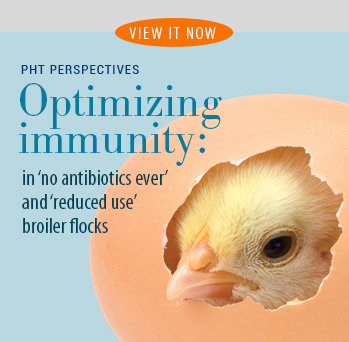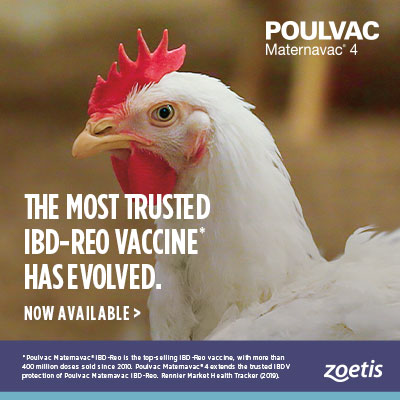Focus on the details to ensure ILT vaccination success

An interview with Dale Gambrill, Senior account manager, Zoetis
Q: How serious are infectious laryngotracheitis (ILT) outbreaks in poultry flocks?
DG: Dealing with ILT is never a good experience for a poultry farm. It’s an acute respiratory disease which can cause high morbidity in flocks, with average mortality rates between 10% and 20%.
As the virus can be easily transmitted by infected birds, vaccinating flocks against the disease with Laryngo-Vac®, Zoetis’s modified-live virus vaccine, is important. However, vaccination requires care and patience if it’s going to be as successful as it can possibly be.
Q: How do you prevent outbreaks in the first instance?
DG: Biosecurity is key to keeping ILT out of flocks.
Growers are the frontline of defense; they need to know and monitor every person that comes on and off the farm — including themselves and hired personnel. It’s a good habit to document necessary and unnecessary visitors on and off the farm each day in case any infections need to be tracked or traced.
Each farm needs to have dedicated footwear and clothing for employees. It’s vital staff don’t leave the farm in dirty clothing — particularly footwear — and they must not travel back to a farm once they’ve left without changing their clothes and shoes. Clean footwear should be a top priority every day.
Company representatives have responsibilities too. Protective gear such as disposable boots, suits, hairnets and gloves should be used while visiting each farm. All vehicles should be cleaned and disinfected inside and outside daily; tires should be sprayed with a disinfectant before entering a farm’s premises and sprayed when exiting. Service representatives should work birds by age from youngest to oldest flock ages, and they should never travel to another farm if a disease challenge is suspected.
People are often the carriers of disease, so it’s critical to protect birds and your investments by implementing good biosecurity practices. If you need help or advice on where you can make improvements, speak to your company representative.
Q: What are the first steps if you identify an outbreak?
DG: Start by closing areas directly around the break, and stop all non-essential foot traffic and vehicle traffic on and off the farm. Work with your state veterinarian and other integrated companies in the area to develop a plan for vaccinations.
In my experience, we always started in small areas and then extended out. The challenge with ILT vaccination is the application. You have to be very detailed, very thorough, and it has to be done right.
Because the vaccine needs to be stored between 36° F and 46° F (2° C to 8° C) and requires careful handling, designating one or two staff members to focus on administering the vaccine is a good approach.
In my experience, however, I found that depending on service technicians was often better. Treating multiple houses across a farm is a big and time-consuming job — and very often farm staff can take shortcuts if they have other things on the farm to think about.
While having more people on-farm can add to the biosecurity challenge, the benefits of having people who are solely focused on getting the job right invariably outweigh the risks. What’s more, technical staff are unlikely to go to any other farms on that day and would clean their vehicles, limiting any risks.
Regardless of how they decide to vaccinate, each company needs a detailed protocol; if there’s a hiccup at any point and some birds miss the vaccine, that can cause rolling reactions, sickness and even morbidity.
Q: What’s the best way to prepare for vaccination?
DG: If you choose to vaccinate in the field with a chicken-embryo-origin (CEO) vaccine, you must have a detailed vaccination protocol. Any CEO vaccine administration should be done thoroughly and methodically.
The CEO vaccine can be administered by spray or in the drinking water. In my opinion, the best way is through drinking lines, and the goal is for every bird to receive the vaccine when they drink. Before beginning vaccination, take an inventory on each farm to make sure that medicators and pumps are working properly, and make sure that service techs have spare parts.
Making sure the right equipment is in the right place is also critical. Even things as simple as having clean buckets to mix the vaccine is important to reduce delays or any risk of contamination. Having plenty of buckets available to drain water out of drinker lines is also vital.
The amount of time the water is turned off is critical, as you need to create a desire for water so that the birds will drink from medicated water lines. In my experience, we would target 2 to 3 hours, but you need to factor in changes depending on the time of year; it could be as much as 4 hours in cooler weather.
Q: How do you make sure you’re administering the vaccine properly through water lines?
DG: Mixing of the vaccine is very important, as is the type of water used. In my experiences on-farm, we always used a vaccine stabilizer product with a dye so that it would buffer chlorine and help us see that each line was drained properly.
When starting the process, it’s important to flush each line until you can see the blue dye reach the ends. Then, lower each drinker line at the same time, and walk the birds every 15 to 20 minutes to make sure each bird is able to get to the water.
Each vaccination period should last for a minimum of 4 hours. When I was working in live production, we would formulate the volume we wanted to use so that it lasted longer than our target time.
If we had experienced any process challenges and felt like we had missed birds, we would repeat the vaccination the next day. The goal is to make sure all birds have a chance to drink during the vaccination process.
While spray application is possible, the technique can be challenging. Unless those administering the vaccine feel confident with a spray, we often found it was more effective to use a medicator or water barrel.
Q: Could anything else go wrong?
DG: Some of the other challenges in ILT vaccination are around farm management, including temperatures in the barn, how the birds are turned out, and sanitation of water lines — an issue which is often overlooked. Bird quality can also pose some challenges.
Post-vaccination, it’s important that birds are kept comfortable so that stress caused by the vaccine is limited. Post-vaccine birds will feel a little feverish and won’t eat as normal for a day or two, so you need to keep an eye on them to check they are eating and drinking, and make sure temperatures are kept at a comfortable level.
Ultimately, there are many variables which need to be right when it comes to ILT vaccination, but most of the challenge comes down to taking the time to do things right. Being thorough and methodical in managing the process is what’s important.
TOOLBOX, Issue 35
Toolbox is a series of interviews with veterinarians and other technical specialists about their experiences managing antimicrobials, vaccines and other tools for poultry health. It is produced by the editors of Poultry Health Today on behalf of the US Poultry Business of Zoetis.
BIO-00354
Aug 2022
Posted on October 19, 2022
 We’re glad you’re enjoying
We’re glad you’re enjoying



















